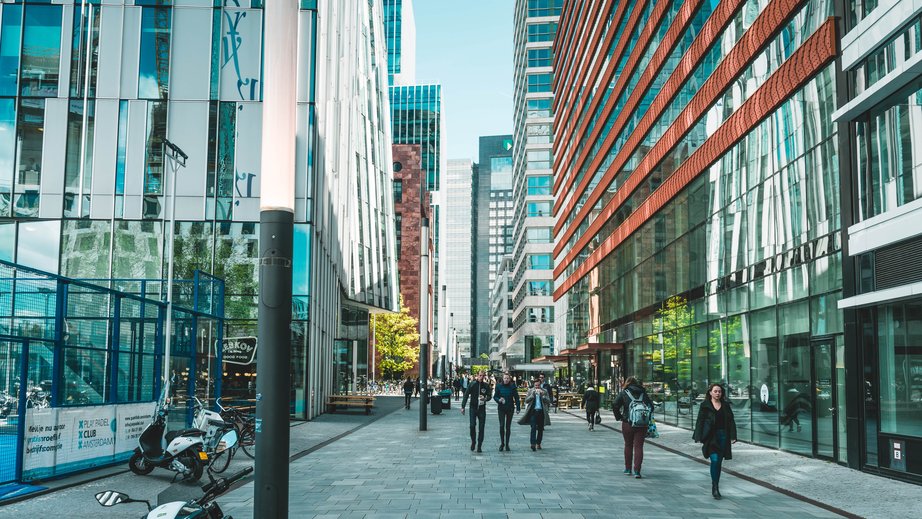Following the English publication of their book, Neuroarchitecture: Designing High-rise Cities at Eye Level, researchers Frank Suurenbroek and Gideon Spanjar organized an online book symposium with leading international researchers. The central theme of the event was to identify design principles from the field of neuroarchitecture that contribute to a healthy city. At the online symposium, researchers from various disciplines including architecture, landscape architecture, and urban planning discussed the latest developments from the hybrid field of neuroarchitecture. The symposium attracted over 150 participants.
Neuroarchitecture book launch
In Neuroarchitecture Suurenbroek and Spanjar, both from the Amsterdam University of Applied Sciences, demonstrate how eye-tracking technology can be used to capture the experience of urban designs at eye level. By linking interviews with eye movement analysis, it can be determined the extent to which users, mostly unconsciously, absorb visual information from their surroundings. Examples of street views with high-rise buildings in cities around the world, including Vancouver, Oslo, and Amsterdam were used to illustrate how user experiences can be positively influenced by design principles. These include the integration of public and private spaces, the ratio of street width to building height, and diversity in materials.
Human Scale
Asked whether the authors also considered other senses in the book, Spanjar replied that mobile eye trackers can be used to precisely record and identify where a subject not only looks but also listens to sounds. “We found that in our mobile eye tracking studies, sound has a huge impact on directing attention.” According to the researchers, these biometric technologies provide tools for designing cities that take into account the human scale and the way users absorb visual information from their environment. “Reality shows that urban planners and (landscape) architects have to take many things into consideration in order to preserve essential elements during the design process,” says Suurenbroek. “This research is a first step towards evidence-based knowledge about the type of design solutions that maintain a human scale. This is essential for professionals who are involved in a massive densification operation.”
How Technology Helps to Create Human-Scale High-Rise Cities at Eye Level
In Neuroscience for Designing Green Spaces: Contemplative Landscapes, neuroscientist and landscape architect Agnieszka Olszewska-Guizzo, founder of the NGO Neurolandscape, illustrates the stress-reducing effect of key spatial characteristics such as color, light, and the shape of green spaces. They can facilitate a so-called state of contemplation. This research is in line with the growing interest in the positive impact of green spaces in densified environments and the realization that green “restorative” spots are not an afterthought but an essential consideration when working on well-being in the city.
Guide for Design
Although European policy clearly focuses on nature as a panacea for solving many urban problems, Olszewska-Guizzo pointed out that there is still no evidence-based method for designers to determine which design principles of green design elements contribute to well-being. When she was asked whether neurodesign is purely aimed to quantify the impact of design, she replies that “there is a difference between design based on empathy, intuition, and inspiration or scientific evidence.” Her work provides an evidence-based tool for professionals that they can use not only to assess the quality of urban green but also use as a guide for future design.

In Tuning Architecture with Humans: Neuroscience Applied to Architectural Design, architect-researcher Davide Ruzzon (University of Venice) offers a unique anthropological perspective on the relationship between humans and architecture. Ruzzon uses human evolution as a lens to explore how the interaction between architecture and the environment has unfolded over time. The author argues that architectural designs cannot be seen separately from the natural forms and structures in which human evolution has taken place. This highlights the imperatives of understanding the instinctive interactions of humans with the built environment and the recognition of designs that not only recognize but also strengthen these natural connections.
Response to Environment
Justin Hollander, professor Urban and Environmental Policy and Planning at Tufts University, and Ann Sussmann, founder of the Human Architecture and Planning Institute (HAPI) were the final speakers. This Boston-based research team explores the potential of innovative biometric technology to measure users’ initial unconscious emotional responses when they scan the environment. The team’s toolkit includes not only eye tracking, but also technology to measure heart rate, facial expressions and sweat conductivity.

From left to right: Justin Hollander, Davide Ruzzon, Olszewska Guizzo, Frank Suurenbroek, Ann Sussman, Gideon Spanjar. Amsterdam University of Applied Sciences.
In Cognitive Architecture: Designing How We Respond to the Built Environment, the researchers illustrate how subtle design elements impact perception and elicit emotional responses. Hollander and Sussmann used the example of a prestigious modernist design with a glass façade that hardly attracts any attention, in contrast with the surrounding billboards, pedestrians, or vehicles. “All that effort on the design and nobody looks at it. It’s practically invisible,” says Hollander.
Besides biometric technology, Sussman and Hollander discuss the emergence of AI software, with certain models already able to predict with 92 percent accuracy where people look in urban environments. While commercial organizations have long embraced the use of biometric techniques and AI for neuromarketing, there is little awareness of these technologies among design professionals. The audience was curious about how these technologies can be integrated into the daily practice of urban planners and architects. Sussman pointed out that establishing a scientific knowledge base about user experience in urban areas is an important first step. It will require a significant effort to integrate these technologies into daily practices to the extent that other professionals have done. Sussman emphasizes that “there is an urgency to get the science out there.”
Taken together, the research findings presented by the speakers illustrate the potential of the new field of neuroarchitecture. By embracing neuroarchitecture and using innovative technologies in daily practice, professionals can design cities that not only meet current needs but also promote the well-being of future generations.
The article was published earlier in Dutch at Gebiedsontwikkeling.nu
“Boeksymposium richt spotlight op neuroarchitectuur en gezonde steden”
Cover image: ‘Claude Debussylaan op de Zuidas, Amsterdam’ by David Peperkamp (source: shutterstock.com)

